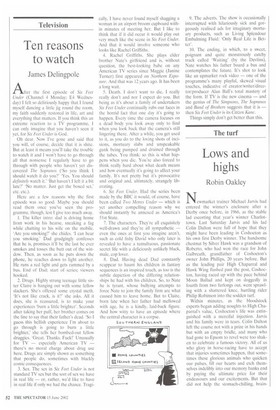Ten reasons to watch
James Delingpole A ter the first episode of Six Feet Under (Channel 4 Monday; E4 Wednesday) I felt so deliriously happy that I found myself dancing a little jig round the room, my faith suddenly restored in life, art and everything that matters. If you think this an extreme reaction to a TV programme, I can only imagine that you haven't seen it yet, for Six Feet Under is God.
Oh dear. Now I've gone and said that you will, of course, decide that it is shite. But at least it means you'll take the trouble to watch it and I won't have to go through all that nonsense I regularly have to go through with people who haven't yet discovered The Sopranos (`So you think I should watch it do you?—Yes. You should definitely watch it.—But haven't I left it a bit late?' No matter. Just get the boxed set,' etc. etc.).
Here are a few reasons why the first episode was so good. Maybe you should read them once you've seen the programme, though, lest I give too much away.
1. The killer intro: dad is driving home from work in his hearse, sneaking a fag while chatting to his wife on the mobile, 'Are you smoking? she chides. '1 can hear you smoking.' Dad grudgingly confesses that he is, promises it'll be the last he ever smokes and tosses the butt out of the window. Then, as soon as he puts down the phone, he reaches down to light another. He runs a red light and gets rammed by a bus. End of Dad; start of series; viewers hooked.
2. Drugs. Highly strung teenage little sister Claire is hanging out with some fellow slackers. She's offered some crystal meth. 'It's not like crack, is it?' she asks. All it does, she is reassured, is to make your experiences 'burn a little brighter'. Seconds after taking her puff, her brother comes on the line to say that their father's dead. 'So I guess this hellish experience I'm about to go through is going to burn a little brighter,' she tells her bombed-out fellow druggies. 'Great. Thanks. Fuck!' Unusually for TV — especially American TV — there's no moral charge about drug use here. Drugs are simply shown as something that people do, sometimes with blackly comic consequences.
3. Sex. The sex in Six Feet Under is not standard TV sex but the sort of sex we have in real life — or, rather, we'd like to have in real life if only we had the chance. Tragi
cally, 1 have never found myself shagging a woman in an airport broom cupboard within minutes of meeting her. But I like to think that if it did occur it would play out very much like the scene in Six Feet Under. And that it would involve someone who looks like Rachel Griffiths.
4. Rachel Griffiths. She plays elder brother Nate's girlfriend and is, without question, the best-looking babe on any American TV series since Maggie (Janine Turner) first appeared on Northern Exposure. And that was 12 years ago. It has been a long wait.
5. Death. I don't want to die, I really really don't and nor I expect do you. But being as it's about a family of undertakers Six Feet Under continually rubs our faces in the horrid fact that one day it's going to happen. Every time the camera focuses on a dead body you look away only to find when you look back that the camera's still lingering there. After a while, you get used to it, as you do to the loving shots of incisions, mortuary slabs and unspeakable gunk being pumped and drained through the tubes. You think: so this is what happens when you die. You're also forced to think really hard about what death means and how eventually it's going to affect your family. It's not pretty but it's provocative and original and, ultimately, strangely liberating.
6. Six Feet Under. Had the series been made by the BBC it would, of course, have been called Two Metres Under — which is yet another compelling reason why we should instantly be annexed as America's 51st State.
7. The characters. They're all exquisitely well-drawn and they're all sympathetic — even the ones at first you imagine aren't, such as cold fishy David who only later is revealed to have a tumultuous, passionate secret life with a deliciously unlikely black, male, cop lover.
8. Dad. Having dead Dad constantly reappear to haunt his children in fantasy sequences is an inspired touch, as too is the subtle depiction of the differing relationships he had with his children. So, to Nate he is tyrant, whose bullying attempts to force Nate to join the family firm are what caused him to leave home. But to Claire, born late when her father had mellowed with age, he is a kindly, laid-back figure. And how witty to have an episode where the central character is a corpse.
Sou ENGLAN4b
9. The adverts. The show is occasionally interrupted with hilariously sick and gorgeously realised ads for imaginary mortuary products, such as Living Splendour Embalming Fluid: 'Only Real Life is Better'.
10. The ending, in which, to a sweet, poignant and quite monstrously catchy track called 'Waiting' (by the Devlins), Nate watches his father board a bus and contemplates the future. It's shot to look like an upmarket rock video — one of the programme's many playful, skewed visual touches, indicative of creator/writer/director/producer Alan Ball's total mastery of the form. If TV is the new cinema — and the genius of The Simpsons, The Sopranos and Band of Brothers suggests that it is — then Six Feet Under is its Citizen Kane.
Things simply don't get better than this.


































































 Previous page
Previous page